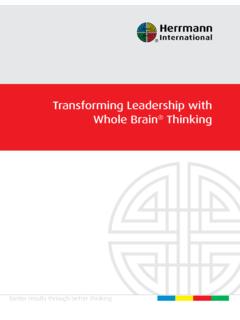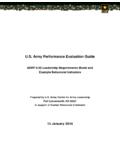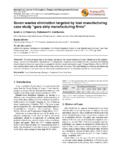Transcription of Ten Steps to Developing Agile Leaders in a …
1 ARTICLEby Ann Herrmann-Nehdi Herrmann InternationalTen Steps to Developing Agile Leaders in a Complex WorldarticleCopyright 2012 Herrmann International, All Rights Reserved Page 1 The world has changed, why won t they? Although this is nothing new it s a problem that has plagued managers for decades the questions it raises today are more business critical than the conversation evolved, we discussed all the obstacles that were getting in the way of these needed shifts in thinking. Even though these were all very smart people dedicated, hardworking and aligned with the strategy of the company something was missing.
2 We defined the needed competencies, administered a 360, and they all heard what they needed to do to make these changes. Then we gave them that not enough? he continued, shaking his head in irritation. I know the buck stops with me as their leader, but frankly, I am out of ideas! What is a leader to do? These complaints are not specific to any one organization or country. In fact, they are products of the same underlying issues: An ever increasing workload with no end in sight. Role complexity and bundling with no time to adjust definition or expecta-tions.
3 Challenges leading cognitively diverse teams effectively in virtual environ-ments. Lack of time for coaching, training and development, even when it is planned and budgeted for. Change fatigue creating an attitude of why bother it ll just change again anyway. Business imperatives that require more risk taking and innovation when a fear of failure still pervades in the culture. Managing and leading up to four generations in the workplace, each of which requires a differentiated leadership style. Why is it so hard for our people to shift their thinking?
4 It is so obvious to me that their thinking needs to change, a frustrated senior line leader for a global multinational recently 2012 Herrmann International, All Rights Reserved Page 2At the same time, the expectations for better results, faster turnarounds, in-creased growth, higher customer satisfaction, competitive differentiation aren t decreasing. In fact, we re demanding more. We are up against momentous challenges, but we re trying to tackle them with ordinary tools, often relying on the tools and processes that have worked for us in the World, Old Education?
5 Most Leaders were educated for a different world, at least in their formal educa-tion. Younger Leaders , who grew up in an environment more virtual by design and more prone to disruption and radical change, have somewhat of an advantage in acclimating to today s business realities, but they lack experience dealing with the way large, complicated organizations function. They can be frequently frustrated by the collaborative effort required to get things done, and the moving targets of huge complex projects with continually changing or unclear milestones. That lack of experience can present a big gap they don t know how to experienced Leaders have the challenge of moving at the speed of informa-tion, trying to get systems and tools that were designed for other eras to work in today s environment.
6 They re also saddled with what Made to Stick , authors Chip and Dan Heath, call a curse of knowledge that hinders their ability to look at fresh thinking with objectivity. In this case, knowledge and experience get in the way of their ability to flex and adapt to a new environment to have, in a word, Meister, author of Workplace 2020, recently stated in her Forbes blog, 2020 Workplace: Preparing For The Future, In the workplace of the future, employees will increasingly need to work in small, self-organized teams and be skilled in Agile management, critical thinking and virtual teaming.
7 She goes on to talk about teachers she has interviewed who are training kin-dergarteners on how to use Twitter. One of the teachers reveals, It s not the technology that matters, it s the flexibility of mind. You have to be able to say, Well, OK, that didn t work; let me try this. Kids are by nature that way, but this needs to be fostered. Kids, whose brains are still more plastic or adaptable than adult brains, do have the added advantage of operating in an environment that fosters mental agility. We adults need to learn to embrace thinking agility, too, as Meister goes on to describe: That kind of flexibility will be crucial in order to thrive in the workplace of the future.
8 Learning and working are becoming one and the same, and agility is a major competitive advantage for companies. More experienced Leaders have the chal-lenge of moving at the speed of information, trying to get systems and tools that were designed for other eras to work in today s environment. articleCopyright 2012 Herrmann International, All Rights Reserved Page 3 The Whole Brain Model graphic is a trademark of Herrmann many ways, much of what we are asking our brains to do at work has changed dramatically. We keep changing the assignment, and yet our systems, job descriptions, learning models and platforms, baseline measures, evaluation processes, and thinking about leadership development have not kept Maps at WorkWhat is going on in our heads that either helps or impedes our mental agil-ity?
9 David Rock and Jeffrey Schwartz provide some insight in their article, Neuroscience of Leadership: Cognitive scientists are finding that people s mental maps, their theories, expectations, and attitudes, play a more central role in human perception than was previously understood. In the article they go into further detail about how difficult it can be to change our thinking and our way of being, since that literally requires we change our brains. This explains the mechanics behind the curse of knowledge the Heath brothers are talking about in Made to Stick.
10 Designed to be highly efficient, your brain is a pattern searching machine. Whenever you encounter a situation, your brain scans to see if this has been seen before, and if it has, it activates that part of the brain. This is why you may have a solution to a problem in your head before a colleague has even finished describing it. That efficiency has a downside, though, because it gets in the way of our ability to flex our thinking to a new place. These mental defaults can become mental blind spots-potential roadblocks to thinking good news is we can learn to override these defaults, however, it requires that we understand and remain aware and mindful of our mental process so we can manage it rather than having our mental process manage us.



